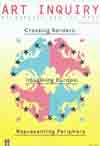The Catalague of Walls. A Collective Memory of Europeans
The Catalague of Walls. A Collective Memory of Europeans
Author(s): Roman BromboszczSubject(s): Social Sciences
Published by: Łódzkie Towarzystwo Naukowe
Keywords: walls; citizens; culture; society; collective memory; exclusion; Berlin Wall
Summary/Abstract: Why do the citizens of Europe build walls? What is so solid in a wall to endow it with the power of division? The Berlin Wall is just one example of the enactment of political power. This paper is an attempt to catalog the most prominent walls, including The Long Walls (450-404 B.C.) from Athens to Piraeus, the Walls of Servious (378 B. C.), the Wall of Hadrian (121 A.D.), the Walls of Antonius (282 A.D), The Wall of Constantine (324 A.D.), the Wall of Theodosius II (408 A.D.), the Wall of the Warsaw ghetto (1941), and the Berlin Wall (1961-1989). Together they make up a broad horizon of barriers, differences, ethnicity and economic embargo, they comment on a historical condition such as the Cold War, and finally they prefigure a new world order. The aim of the paper is to outline some of the quantitative and qualitative characteristics of the walls. I will then explore them as forms of division based largely on religion and economy. Lastly, I will give special attention to the Berlin Wall.
Journal: Art Inquiry
- Issue Year: 2013
- Issue No: 15
- Page Range: 139-151
- Page Count: 13
- Language: English

